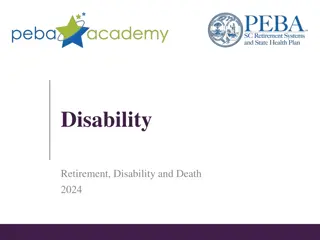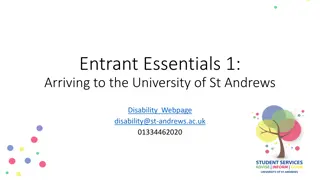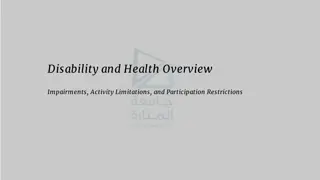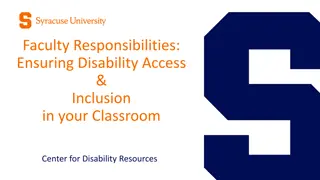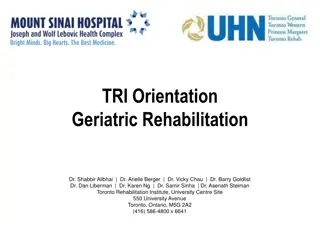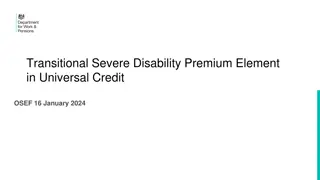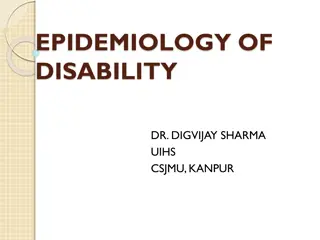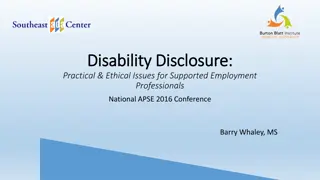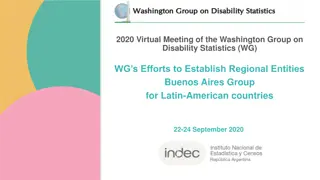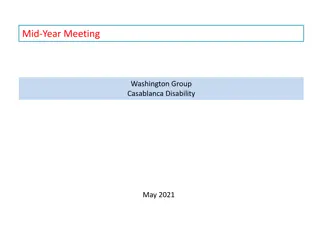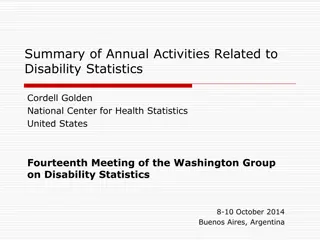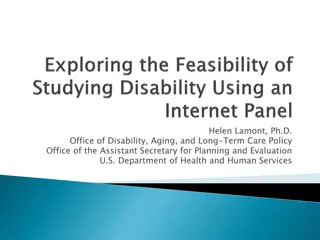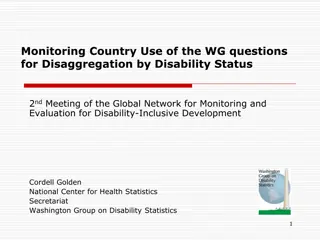Evaluation of Ricky M. for Learning Disability
Ricky M., a second-grade student referred for a learning disability evaluation, shows limited English proficiency and is enrolled in a Sheltered English Immersion program. Despite receiving support, concerns persist regarding his academic progress. Observations in the classroom reveal Ricky working independently but seeking guidance and support from peers and teachers. The evaluation aims to determine Ricky's eligibility and need for special education services in light of his academic challenges and English language development.
Download Presentation

Please find below an Image/Link to download the presentation.
The content on the website is provided AS IS for your information and personal use only. It may not be sold, licensed, or shared on other websites without obtaining consent from the author.If you encounter any issues during the download, it is possible that the publisher has removed the file from their server.
You are allowed to download the files provided on this website for personal or commercial use, subject to the condition that they are used lawfully. All files are the property of their respective owners.
The content on the website is provided AS IS for your information and personal use only. It may not be sold, licensed, or shared on other websites without obtaining consent from the author.
E N D
Presentation Transcript
CASE: RICKY M ELL STUDENT REFERRED FOR LEARNING DISABILITY EVALUATION
REASON FOR REFERRAL Ricky was referred for this initial evaluation in order to determine his eligibility and need for special education services. Ricky s parents do not report concerns for learning or behavior at home. School staff referred Ricky due to concerns for academic progress in spite of receiving support in the form of small group intervention.
BACKGROUND Age 8-6 Grade 2 Spanish only at home No developmental delays No medications Hearing/Vision normal No social/emotional or behavioral concerns
ELL DATA Ricky is classified as having Limited English Proficiency (LEP) and is enrolled in a Sheltered English Immersion program at school. His level of English proficiency, as measured by the ACCESS for ELLs is 3.2 (developing). Specifically, Listening: 1.6 (entering) Speaking: 3.9 (developing) Reading: 3.6 (developing) Writing: 3.4 (developing)
CLASSROOM OBSERVATIONS Unstructured Student Observation: When the observation began, the students were working on a writing assignment about a gingerbread person. The teacher played holiday music in the background as the students were working. The students were permitted to work at their desks or on the carpet in front of the classroom. Ricky worked independently on the carpet. He set out working on his own, but after a few minutes, began to look on to a nearby peer s paper. After approximately 15 minutes of this activity, the teacher signaled a transition. She signaled the transition by clapping; the students responded in turn by clapping with their own pattern. Next, the teacher led the students through some brief calming/breathing exercises, and then began the math lesson. The teacher introduced a mathematics lesson on rounding by posing a problem-solving activity. After this introduction, she dismissed the students to their tables to work on the word problem, and set a timer for five minutes. Ricky returned to his seat and worked on the problem, quietly socializing with a neighbor. Ricky raised his hand and asked for clarification from the teacher. Ms. S provided Ricky a few minutes of individual support, and then encouraged him to write his response to the problem. Again, he looked to a neighbor s paper. After five minutes, the timer went off and the students returned to the front carpet. Ms. S asked for student volunteers to share their answers to the word problem. She illustrated the concept of a midpoint by drawing a number line on the board. Though Ricky was attentive to the teacher and his peers, when Ms. She called on him to share, he was unable to provide a response. Ms. S continued to illustrate visual estimations by drawing number lines. Ricky was attentive throughout the lesson. Next, the teacher again announced a transition. She selected Ricky to be the calming coach to lead the class in brief breathing/calming exercises, which he did. The students returned to their tables to work on problems in their workbooks. Ricky volunteered to read the directions out loud to the class; he did so successfully. Then focusing on his own workbook, Ricky wrote, erased, and re-wrote, drawing his number lines. He worked independently, but occasionally looked to a neighbor s paper. As the teacher circulated the room, she provided Ricky with individual guided support, and he was able to solve the problems with this assistance.
CLASSROOM OBSERVATIONS Generally, this evaluator found the classroom to be quiet, well-managed, with clearly established routines. There was a high degree of academic engaged time/time on task. Ricky was attentive, followed along with instruction, and participated nicely in the lesson. He was appropriately sociable with his classmates. Overall, he had some difficulty working independently as evidenced by looking to classmates work, but with some adaptive help- seeking behavior such as raising hand and asking for support from the teacher.
TESTING OBSERVATIONS Ricky willingly separated from his classroom to join the School Psychologist for testing. He appeared his stated age, and was easily engaged in casual conversation regarding his family, friends, and school experience. Rapport was established and maintained throughout the sessions. Ricky s level of conversational proficiency was age appropriate, with typical social reciprocity and back-and-forth conversation. He used some grammatical and inflection patterns typical of dual-language learners. He also had some difficulty with word recall, at times confusing similar words (e.g., barn/bench), and at times having difficulty expressing himself clearly. During testing, Ricky was exceptionally cooperative with all tasks presented, and it was felt he gave excellent effort, even when the work became increasingly difficult. Though he occasionally squirmed in his seat, his level of activity was age- appropriate. Ricky was attentive to the presentation of all tasks. However, at times, he did not seem to comprehend the instructions, especially with sequencing tasks (e.g., first/then). His performance improved with the opportunity to receive feedback and correction on early test items. Ricky s demeanor was calm and pleasant; there were no signs of testing-related anxiety. His response style was somewhat rushed, especially with difficult tasks.
The Wechsler Intelligence Scale for Children, Fifth Edition (WISC-V) The WISC-V is an individually administered, comprehensive clinical instrument for assessing the cognitive abilities of children and adolescents. The scaled score mean is 10 with an average range of 8-12. The standard score mean is 100 with an average range of 90-110. WISC-V Subtest Scaled Score (95% Confidence Interval) Similarities 7 Verbal Comprehension Index (VCI) = 73 Index Score Full Scale IQ (95% Confidence Interval) (68-83) 4thPercentile Well Below Average Visual-Spatial Index (VSI) = 64 (59-75) 1stPercentile Significantly Below Average Fluid Reasoning Index (FRI) = 74 (69-83) 4thPercentile Well Below Average Working Memory Index (WMI) = 72 (67-82) 3rdPercentile Well Below Average Processing Speed Index (PSI) = 83 (76-94) 13thPercentile Below Average RESULTS: COGNITIVE Vocabulary 3 Block Design 3 (Visual Puzzles) (4) Full Scale IQ (FSIQ) = 66 (62-73) 1stPercentile Significantly Below Average Matrix Reasoning 4 Figure Weights 7 Digit Span 5 (Picture Span) (5) Coding 5 (Symbol Search) (9)
The Kaufman Test of Educational Achievement, 3rdEdition (KTEA-3) The KTEA-3 is an individually administered measure of academic achievement that provides an analysis of academic strengths and weaknesses in reading, mathematics, written language, and oral language. The KTEA-3 provides a norm-referenced assessment, but allows for criterion-referenced analysis of errors in certain areas. This instrument is intended for examinees age 4 through 25. The standard score mean is100 with an average range of 85-115, representing a range that is +/- 1 SD from the mean. Grade Equivalent scores are not reported as they are misleading and may be inaccurate. Norms used: Age KTEA-3 Subtest Std Score Percentile Descriptive Category Composite Score (95% Conf.) Letter & Word Recognition 95 37th Average Reading Composite= 89 (83-95) 23rdPercentile (Low) Average Reading Comprehension 86 18th (Low) Average Silent Reading Fluency 67 1st Significantly Below Average Math Concepts & Applications 82 12th Below Average Math Composite= 84 (78-90) 14thPercentile Below Average Math Computation 88 21st (Low) Average Written Expression 70 2nd Well Below Average Written Lang. Composite= 83 (77-89) 13thPercentile Below Average Spelling 97 42nd Average RESULTS: ACHIEVEMENT
The Kaufman Test of Educational Achievement, 3rdEdition (KTEA-3) Reading-Related Composites The KTEA-3 includes a set of subtests that are specifically related to reading, including sound-symbol relationships, decoding, reading fluency, and reading understanding. The standard score mean is 100 with an average range of 85-115. Norms used: Age KTEA-3 Reading Subtest Std Score Percentile Descriptive Category Composite Score (95% Conf.) Phonological Processing 73 4th Well Below Average Sound-Symbol = 80 (75-85) 4thPercentile Below Average Nonsense Word Decoding 94 34th Average Letter & Word Recognition 95 37th Average Decoding = 94 (90-98) 34thPercentile Average Nonsense Word Decoding 94 34th Average RESULTS: READING-RELATED PROCESSES
Adaptive Behavior Assessment SystemThird Edition (ABAS-3) The Adaptive Behavior Assessment System (ABAS-3) is an assessment of the skills necessary to function effectively in one s environment. The ABAS assesses daily activities required for personal and social sufficiency in the following areas: communication, community use, functional academics, school/home living, health and safety, leisure, self-care, self-direction, and social skills. Scores are expressed as scale scores (Mean=10; SD=3) and standard scores (Mean=100; SD=15). Standard scores have an average range of 90-110. Teacher Form Skill Area Scaled Score Composite Score (95% Conf.) General Adaptive Composite (95% Conf.) RESULTS: ADAPTIVE BEHAVIOR (TEACHER) Communication 5 Conceptual Skills Composite = 84 14 (78-90) Below Average th Percentile Functional Academics 9 GAC = 92 30 (88-96) Average Self-Direction 8 th Percentile Leisure 9 Social Skills Composite = 96 39 (90-102) Average th Percentile Social 10 Community Use 5 Practical Skills Composite = 99 47 (92-106) Average School Living 11 th Percentile Health and Safety 12 Self-Care 13
RESULTS: ADAPTIVE BEHAVIOR (PARENT) Adaptive Behavior Assessment System Third Edition (ABAS-3) The Adaptive Behavior Assessment System (ABAS-3) is an assessment of the skills necessary to function effectively in one s environment. The ABAS assesses daily activities required for personal and social sufficiency in the following areas: communication, community use, functional academics, school/home living, health and safety, leisure, self-care, self-direction, and social skills. Scores are expressed as scale scores (Mean=10; SD=3) and standard scores (Mean=100; SD=15). Standard scores have an average range of 90-110. Parent Form: completed with interpreter Skill Area Scaled Score Composite Score (95% Conf.) General Adaptive Composite (95% Conf.) Communication 3 Conceptual Skills Composite = 73 4th Percentile (67-79) Well Below Average Functional Academics 5 Self-Direction 8 GAC = 85 16th Percentile (81-89) Low Average Leisure 14 Social Skills Composite = 117 87th Percentile (110-124) Above Average Social 12 Community Use 3 Practical Skills Composite = 82 12th Percentile (76-88) Below Average Home Living 6 Health and Safety 5 Self-Care 14
CONCLUSIONS? What else would you want to know? How would you obtain that information? What are your hypotheses and how would you rule in/rule out?




